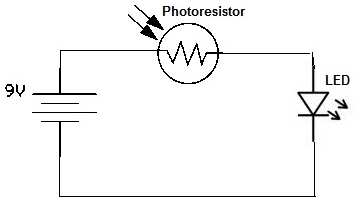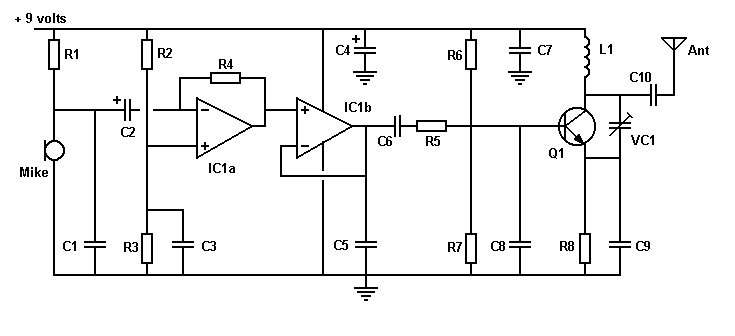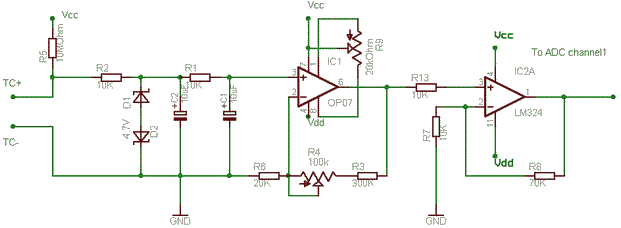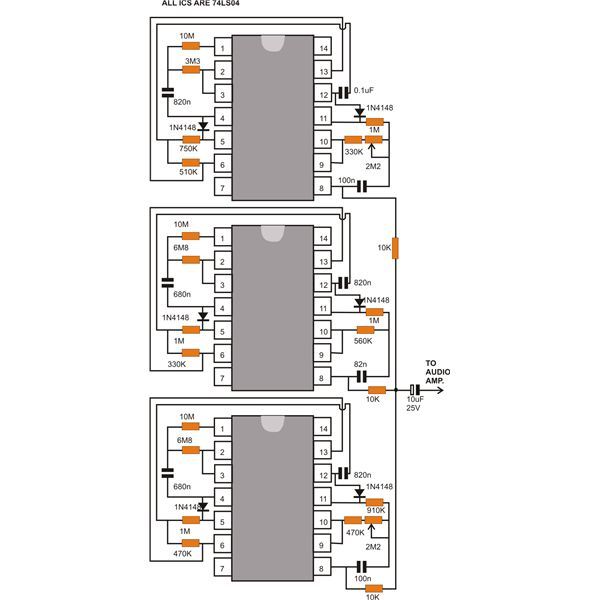
Simple AM Transmitter
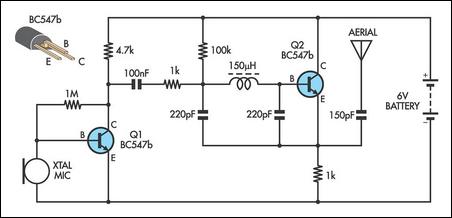
This AM transmitter design is notably simple to construct due to its use of a non-tapped inductor featuring a single winding. The inductor can be conveniently sourced as a standard RF choke, such as the Jaycar Cat LF-1536. To minimize the overall size of the circuit, a traditional tuning capacitor has been replaced with fixed capacitors of 220pF. Frequency adjustments can be achieved by either reducing the value of one or both 220pF capacitors to increase the frequency or by adding additional capacitance.
This AM transmitter circuit operates on the principle of amplitude modulation, where the audio signal is superimposed onto a radio frequency carrier wave. The simplicity of the design is one of its most significant advantages, making it accessible for hobbyists and educational purposes. The RF choke serves as the primary inductive component, ensuring that the circuit remains compact without the complications of winding an inductor.
In this circuit, the fixed capacitors play a crucial role in defining the resonant frequency alongside the RF choke. The resonant frequency can be calculated using the formula:
\[ f = \frac{1}{2\pi\sqrt{LC}} \]
where \( L \) is the inductance of the RF choke and \( C \) is the total capacitance in the circuit. By adjusting the capacitance, one can fine-tune the transmitter to the desired AM frequency range.
The transmitter may also include a simple audio input stage, allowing for the modulation of the carrier wave with audio signals, such as from a microphone or an audio playback device. Proper grounding and shielding are essential to minimize interference and ensure clear transmission.
Overall, this AM transmitter circuit exemplifies a practical approach to RF design, emphasizing ease of assembly and effective performance in transmitting audio signals over short distances. The use of readily available components enhances its feasibility for various applications, including educational demonstrations, personal projects, or even experimental radio broadcasting.There are not many AM transmitters that are easier to build than this one because the inductor is not tapped and has a single winding. There is no need to wind the inductor as it is a readily available RF choke (eg, Jaycar Cat LF-1536).
To make the circuit as small as possible, the conventional tuning capacitor has been dispensed with and fixed 220pF capacitors used instead. To tune it to a particular frequency, reduce one or both of the 220pF capacitors to raise the frequency or add capacitance.
🔗 External reference
This AM transmitter circuit operates on the principle of amplitude modulation, where the audio signal is superimposed onto a radio frequency carrier wave. The simplicity of the design is one of its most significant advantages, making it accessible for hobbyists and educational purposes. The RF choke serves as the primary inductive component, ensuring that the circuit remains compact without the complications of winding an inductor.
In this circuit, the fixed capacitors play a crucial role in defining the resonant frequency alongside the RF choke. The resonant frequency can be calculated using the formula:
\[ f = \frac{1}{2\pi\sqrt{LC}} \]
where \( L \) is the inductance of the RF choke and \( C \) is the total capacitance in the circuit. By adjusting the capacitance, one can fine-tune the transmitter to the desired AM frequency range.
The transmitter may also include a simple audio input stage, allowing for the modulation of the carrier wave with audio signals, such as from a microphone or an audio playback device. Proper grounding and shielding are essential to minimize interference and ensure clear transmission.
Overall, this AM transmitter circuit exemplifies a practical approach to RF design, emphasizing ease of assembly and effective performance in transmitting audio signals over short distances. The use of readily available components enhances its feasibility for various applications, including educational demonstrations, personal projects, or even experimental radio broadcasting.There are not many AM transmitters that are easier to build than this one because the inductor is not tapped and has a single winding. There is no need to wind the inductor as it is a readily available RF choke (eg, Jaycar Cat LF-1536).
To make the circuit as small as possible, the conventional tuning capacitor has been dispensed with and fixed 220pF capacitors used instead. To tune it to a particular frequency, reduce one or both of the 220pF capacitors to raise the frequency or add capacitance.
🔗 External reference
